The Desktop Kabini Review Part 1: AMD Athlon 5350 (AM1) Tested
by Ian Cutress on April 9, 2014 8:00 AM EST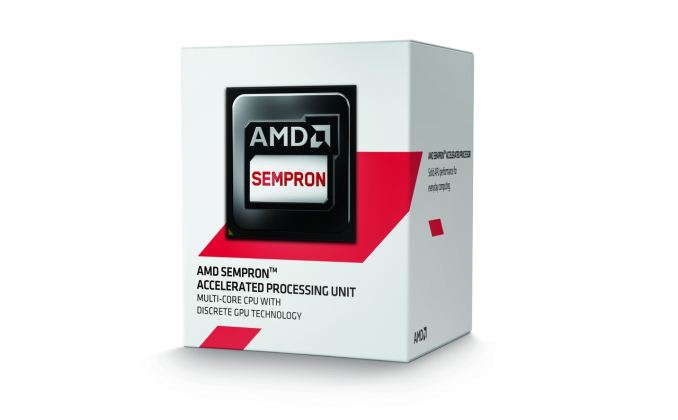
AMD announced earlier in March that it would be launching a socketed desktop Kabini APU. Traditionally the ultra low end/low power SoCs on desktops have come in packages soldered on to motherboards. If you need a faster CPU, you bought a new motherboard with it. With its new AM1 platform, AMD hopes to bring the sort of flexibility enjoyed by the rest of the desktop market to the entry level value segment.
The rationale is simple: the traditional desktop PC is under tremendous price pressure due to the popularity of affordable tablets, notebooks, Chromebooks and Chromeboxes. While there are definitely advantages to a desktop, it's a market that won't grow on its own. The one advantage desktops have over any of the aforementioned modern mainstream computing devices is upgradability. Unfortunately that's a feature that's often lost as we look at the value segment of the desktop market. AM1 attempts to fix that.
A socketed APU is useless without a lineup of APUs to swap in and out of the aforementioned socket, and that's exactly what AMD is launching today. There are a total of four AM1 APUs launching today:
| AMD AM1 Kabini APUs | ||||
|
Athlon 5350 |
Athlon 5150 |
Sempron 3850 |
Sempron 2650 |
|
| CPU Cores | 4 | 4 | 4 | 2 |
| CPU Frequency | 2.05 GHz | 1.60 GHz | 1.30 GHz | 1.45 GHz |
| GPU Cores | 128 | 128 | 128 | 128 |
| GPU Frequency | 600 MHz | 600 MHz | 450 MHz | 400 MHz |
| Memory Frequency | 1600 MHz | 1600 MHz | 1600 MHz | 1333 MHz |
| L2 Cache | 2 MB | 2 MB | 2 MB | 1 MB |
| TDP | 25 W | 25 W | 25 W | 25 W |
| Price | $55 | $45 | $36 | $31 |
Each of these APUs features up to four 28nm Jaguar cores and a 128 SP implementation of AMD's GCN GPU. We've gone over both the Jaguar and GCN architectures in previous articles, so we won't spend a lot of time recapping them here. Jaguar is the latest in AMD's line of "cat" cores, designed to go up against Intel's Atom. GCN on the other hand is a well known GPU design from AMD as well, cut down here to fit in a much smaller die area (and thermal envelope).
This isn't the first time we've seen this Jaguar + GCN combination of course. Kabini first launched as a notebook APU nearly a year ago. Architecturally we're looking at the very same SoC, even down to running at the same max clocks and at the same TDP. The big difference is what we have here today is socketed and targeted at the desktop.
The Athlon and Sempron brands are back and used for AM1 Kabini. The most expensive AM1 APU is the $55 Athlon 5350, a quad core SoC running at 2.05 GHz with a 2 compute unit GCN GPU (128 SP) running at 600 MHz. All four models will have an official TDP rating of 25W, suggesting that they are all the same die and merely binned according to performance.
While the APU costs are low, it's actually the motherboard costs that are most impressive. AMD expects mini-ITX and micro-ATX AM1 motherboards to retail for between $25 - $35. At the low end of the spectrum that means you could be looking at a fully integrated desktop platform for less than $60. Obviously you have to add in the cost of memory, storage, PSU/chassis and heatsink/fan but we're still dealing with an extremely low cost solution.
The real value in having a socketed processor is being able to upgrade the chip without incurring the cost of a new motherboard down the road. Unfortunately AMD isn't saying anything about what future APUs will support Socket-FS1b, so for now all we have is what's in the table above. Given the BGA compatibility between Kabini and Beema, I'd assume we might see a Beema FS1b upgrade at some point. However what comes after that remains to be seen.
Historically AMD has done a good job of maintaining backwards compatibility with sockets for as long as possible, the one challenge being shifts in memory technology. With DDR4 expected to ship at the high end later this year, the DDR3 based FS1b platform should at least have some life in it from a memory compatibility standpoint.
The Platform, Socket & Motherboards
While AM1 is the name of the platform, FS1b is the name of the new socket. AMD sent along a Gigabyte AM1 micro-ATX board (the GA-AM1M-S2H):
The AM1 platform makes for incredibly simple motherboards. There's hardly anything down on the board itself as Kabini is a full blown SoC with integrated memory, PCIe, USB, Gigabit Ethernet and SATA controllers. Gigabyte threw down an iTE Super I/O chip on the motherboard (beneath the heatsink in the lower left) to add serial, LPT, and PS/2 keyboard/mouse ports.
The key points to note here are:
- Single Channel 64-bit DDR3/DDR3L
- Two USB 3.0
- Eight USB 2.0
- PS/2
- Trusted Platform Module Support
- Up to four eDP/DP/HDMI video ouputs
- VGA output
- Four PCIe 2.0 lanes for a discrete GPU/PCIe device
- Two SATA 6 Gbps ports
- One PCIe 2.0 x1 lane allocated to an Ethernet controller
- Three PCIe 2.0 x1 lanes for other controllers (SATA, USB, LAN, WiFi, PCIe 2.0 x1 slots, PCIe to PCI bridges)
As you can see, Kabini provides a good amount of IO. The Gigabyte board includes a single PCIe x16 slot (x4 electrical) and two x1s. You also get two USB 3.0 ports and two USB 2.0 ports on the back header, although the APU itself can support up to 8 USB 2.0 ports. There are also two 6Gbps SATA ports down on the board, the maximum supported by Kabini.
The audio solution has to be cheap to be viable, and we get an ALC887 Realtek codec, which is actually higher end than I expected. Realtek are said to offer a discount when an audio codec and network controller are bought for the same product, so it is no surprise to see a Realtek NIC equipped here.
Because AM1 is a drive to low cost platforms, I do not see many motherboard manufacturers taking advantage and producing works of electrical engineering art. When the most expensive APU you can purchase for a platform is $55, when a motherboard manufacturer starts considering extra controllers or fancy features, the cost/benefit analysis might go out of the window. An extra USB 3.0 controller might add $0.75 to the bill-of-materials, require extra validation and optimization, then add a final $2.50 to the end-user cost (or $4 after retailer markup). After speaking with Patrick from ServeTheHome about the platform, there is certainly scope for adding several NICs to the motherboard and combining its use both as a PC and a router, however none of the motherboards being released with AM1 at launch seem to have more than one.
I was told by AMD that AM1 systems should support memory overclocking above the verified DDR3-1600 speed. This should allow the integrated graphics to stretch its legs a bit more despite the presence of a single channel memory controller should a system integrator consider buying faster memory. Unfortunately at least the Athlon 5350 seems locked to a max multiplier of 20.5x, so there's no hope for easy overclocking of this part at least.
On day one, motherboards should be available from the following vendors:
Once the products are in the market we will attempt to go over them all in one of our motherboard previews, and perhaps a few in full reviews.
With a new socket comes a new heatsink mounting system. Although the rest of AMD's desktop sockets still rely on a latch + lever retention system, Socket-FS1b moves to a push-pin design similar to what Intel uses on its motherboards (albeit with fewer mounting holes, and much simpler mounting/removing due to lower retention force requirements).
At 25W TDP, we might have been hoping for a passive solution, and I am sure that one of the CPU cooler manufacturers will make one, but AMD is playing it safe by using a small active low profile stock cooler. I would hazard a guess that this is an all aluminium construction in order to keep costs down. The reference AM1 HSF is oddly reminiscent of what old "high end" CPUs used to use years ago.
Most AM1 platform motherboards will be similar to what we have here. Some will ship with DisplayPort/DVI, and others might have an extra USB3/SATA controller. I doubt we will see any with audio codecs above the ALC892, or Killer NICs, although there might be an Atheros in the mix.


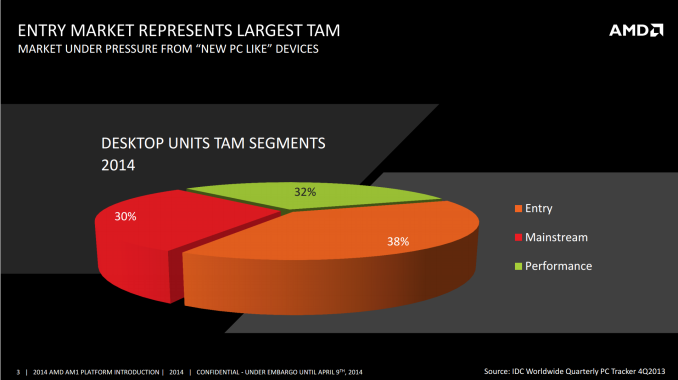
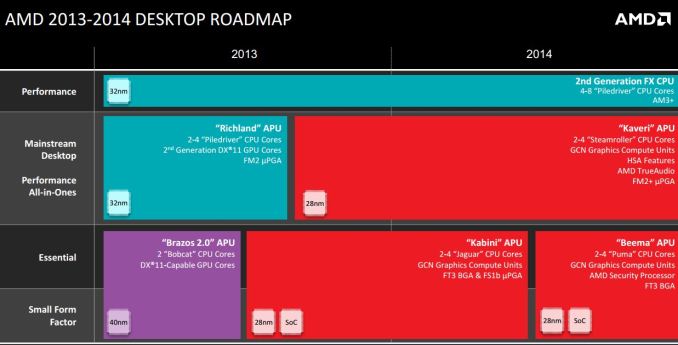







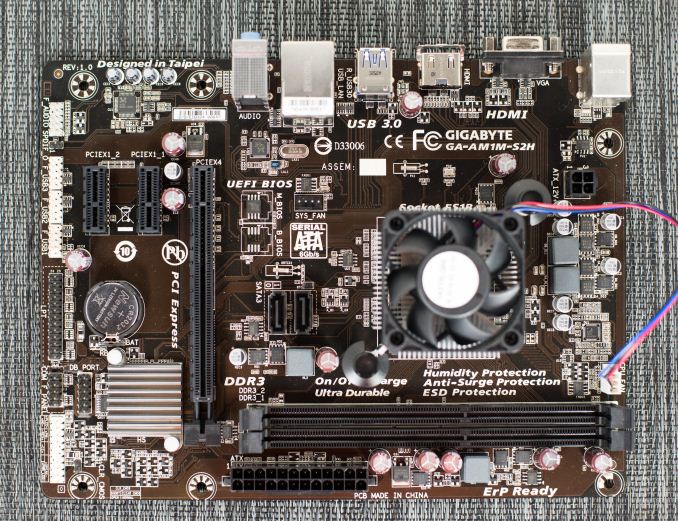
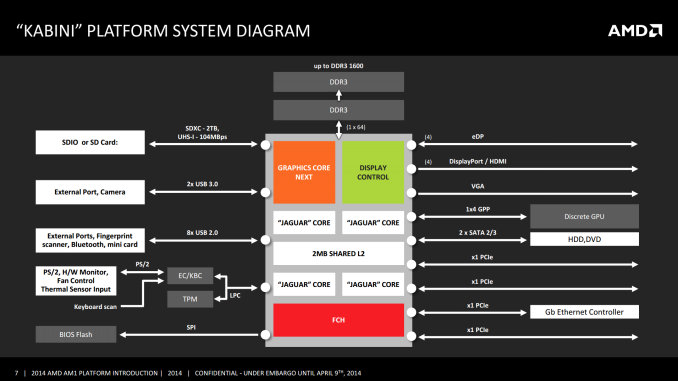
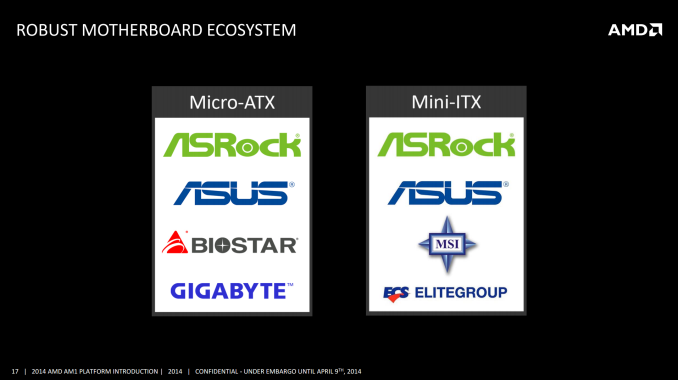
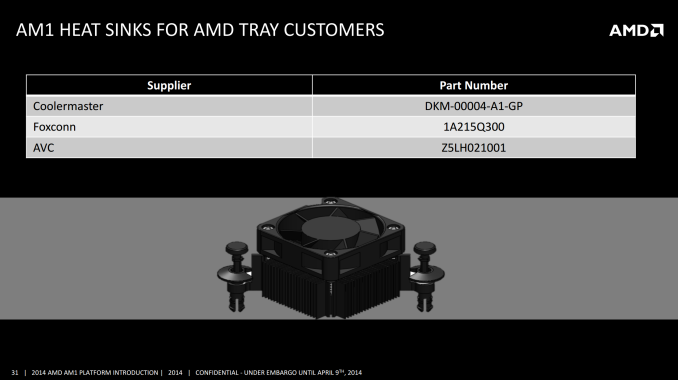
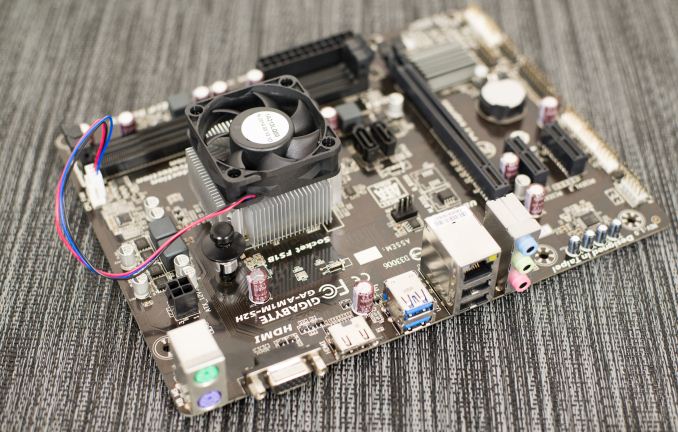
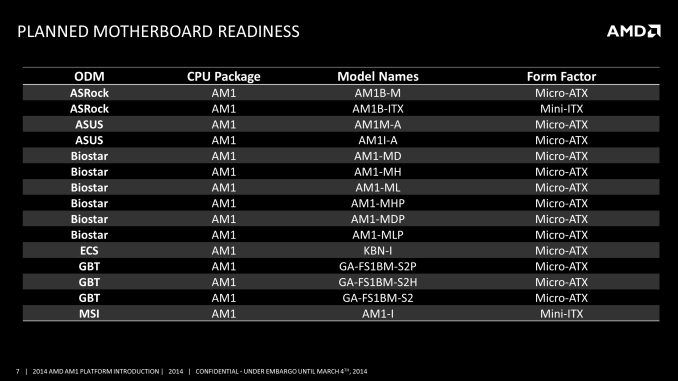








126 Comments
View All Comments
5thaccount - Thursday, April 10, 2014 - link
100% agree. Any Core 2 or newer based system with plenty of memory and an SSD will work fine for most users out there (the ones that use office, browse the web, and watch youtube)... and for quite a few years to come. Heck, I'm still using my E5200 daily after 6 years. Works perfect! Even looking at these benchmarks, the new Kabini is slower than a Core 2 Duo E8400. Which, oddly enough, can be picked up for under $20 on eBay... now that's a deal!jonathanharrison - Thursday, April 10, 2014 - link
I got a whole Vostro 200 system used with 20" widescreen LCD, 4GB DDR2 RAM (667), Core 2 Duo E6550 from a dude on Craigslist for a mere $45. Wife had gone to the Mac side and wanted the system out of the house ASAP. That's one way to do it - all but GIVE it away :)On-board intel graphics kinda don't cut it for gaming, so... when I could, I added a Sapphire Radeon HD 7770 GHz Edition 1GB video card ($109) and a 550W ThermalTake power supply ($40) into it and plugged it also into my other 20" monitor with a HDMI-DVI cable ($8) for a nice dual display... may go triple-head when I can afford to... wireless mouse/keyboard set ($30), Logitech gamepad F310, ($25)... and I've got a pretty nice light/older (DX9/10) gaming system for less than $220 of new purchases...
trueserve - Friday, April 18, 2014 - link
"A CPU only holds value if it is overclockable and the motherboard supports overclocking the processor."wat.
mikato - Friday, April 11, 2014 - link
Yeah, I had a Core 2 Duo E7300 in my wife's gaming system, and then when the latest COD came out with higher requirements, I bought a nice GTX 760 video card to put in there (with bigger PSU), and a better Core 2 Duo E8500 on ebay to go with it. Unfortunately the CPU was still really limiting things though, even after overclocking as much as I could, so in the end I had to build a new system around the video card... got an i5 4670K. But your point is valid. The system was used for HTPC tasks, XBMC, Skype, etc as well and the Core 2 Duos performed just great in everything besides the latest COD game, which is apparently a resource hog.phoenix_rizzen - Wednesday, April 9, 2014 - link
Wouldn't the PCIe x4 slot be the bigger bottleneck?nathanddrews - Wednesday, April 9, 2014 - link
PCIe 3.0 x2 = PCIe 2.0 x4 = PCIe 1.0 x8 = 2GB/sechttp://www.anandtech.com/show/5458/the-radeon-hd-7...
Even with just a PCIe 2.0 x4 electrical, it would still be massively CPU-bound. I wonder if any other manufacturers will bother to do a fully enabled x16 slot?
extide - Thursday, April 10, 2014 - link
They can't, there simply arent enough lanes on the CPU. If they ditched the NIC and uses every single lane for graphics, you could have x8.nathanddrews - Thursday, April 10, 2014 - link
Ah yes, you are correct.jonathanharrison - Thursday, April 10, 2014 - link
Hey, I resemble that. I've got a Radeon HD 7770 GHz being underfed by a Core 2 Duo E6550. Used system bought for cheap then added the video card, purchased new. I guess the 7750 would have been more than enough, but hey, the 7770 was a steal at $109. How's that for a CPU/GPU imbalance? Hey... at least it's in the right direction for gaming. I'd rather be CPU-limited than GPU-limited any day. I can still run 99% of the games out there, and do so with rather high settings and at least 4X AA most of the time. Maybe not 60fps in all games, but in a lot of them, especially the older ones, and getting 30fps or close in some of the newest (like MKKE).etamin - Wednesday, April 9, 2014 - link
In the "key points" on the first page, you listed two SATA 3gbps ports, but the Gigabyte comes with 2x SATA III. The block diagram shows two "SATA 2/3". In any case, two SATA ports is extremely restrictive. If mSATA and/or secondary SATA controllers can be had for the same $35, this would make for a terrific micro media server.